Cannabis Concentrates Guide: THC Oils, Hash, Wax, Shatter & Dabs
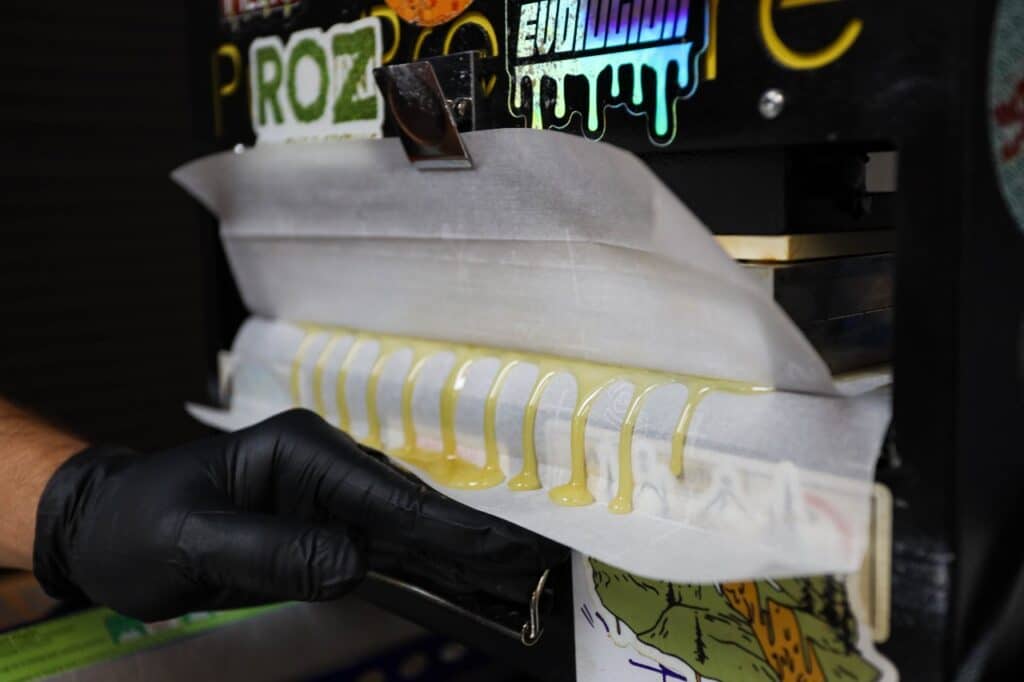
Defining Cannabis Concentrates
Cannabis concentrates are as diverse as they are potent. There are so many different types of concentrates, and every year there is always a new marijuana concentrate released so it’s hard to keep them all straight.
From kief to oils, hashish to shatter, it can be overwhelming to consider trying them, or how to smoke concentrates when you aren’t even sure which is which.
So, what are concentrates?
How are cannabis concentrates made?
How are concentrates, oils, and extracts different?
How much do concentrates cost?
What is a cannabis concentrate?
Concentrates are created and extracted from the cannabis plant, which is much more potent than the flower alone. It’s important to note that there are solvent-based and solventless marijuana concentrates.
The most popular cannabis concentrates include the following:
- Kief or sift
- Hash
- Rosin
- Live Resin
- Shatter Wax
- Crumble Wax
- Honeycomb Wax
- Budder or Badder
- Pull and Snap
- Tinctures
- THC Oil
- BHO & CO2 Extract Oil
- Rick Simpson Oil
- Distillates, Isolates & Crystralines
- Cannabinoid Concentrates
What is a Dab?
A dab is a common name used to categorize many cannabis concentrates that require a dab or oil rig to smoke it. The most common types of dabs are solvent concentrates such as shatter, wax, resin, or types of hash oil.
Solvent Concentrates
Britannica defines a solvent as a substance, ordinarily, a liquid, in which other materials dissolve to form a solution.
So as you can see, these concentrates use a solvent in order to extract the THC, valuable cannabinoids, and terpenes from the marijuana plant.
If a concentrate utilizes a solvent to be created it is referred to as an extract. All extracts are concentrates but not all concentrates are extracts.
Popular solvents used for extraction include CO2, butane, propane, and ethanol. Most of these solvents are highly flammable and have dangerous consequences if not used properly or without proper safety measures in place. These extraction processes can create concentrates with extremely high potencies ranging from 65% to 90% active cannabinoid content.
List of solvent concentrates
- Shatter
- Crumble & honeycomb
- Budder & badder
- Wax products
- Live Resin
- CO2 oil
- THC oil
- Butane-Honey Oil (BHO)
- Rick Simpson Oil (RSO)
Learn About our Denver Hash Facility Tour and Class
Check out our Colorado Hash Class & Facility Tour Combination! w/ expert extract artist Murphy Murri. Learn about terpene profiles, rosin tech, ethanol extraction, and BHO tech with a behind the scenes tour of KrystaLeaves, extraction and production facility.
Solventless or Solvent-Free Concentrates
Concentrates that require no solvent to be created are referred to as solventless concentrates.
These types of concentrates are byproducts that come straight from the cannabis plant and buds themselves like kief and hash. While different types of cannabis concentrates might seem to run together, they are each quite distinct and different.
List of solventless concentrates
- Kief
- Rosin
- Bubble Hash
- Distillates
- Isolates & Crystalline
Types of Concentrates
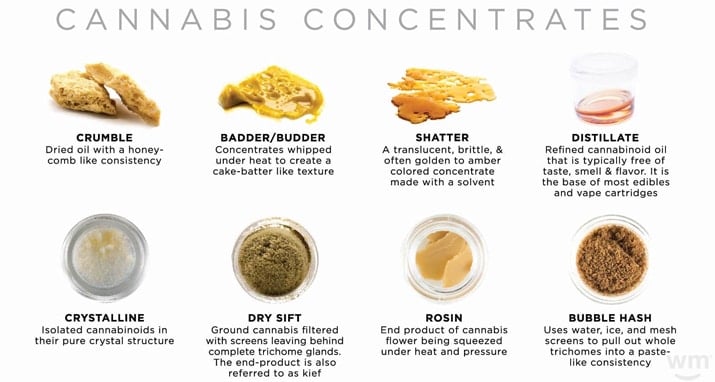
For a full walkthrough of cannabis concentrates, check out this video by Budsbie.
Kief or Sift
What is Kief?
Kief, also known as sift, is the most basic of the THC concentrates. It is a golden powder-like substance that is left behind after the bud is finely ground up and all that is left are the cannabis flower’s trichomes.
What does kief look like?
Kief has a green-goldish color.
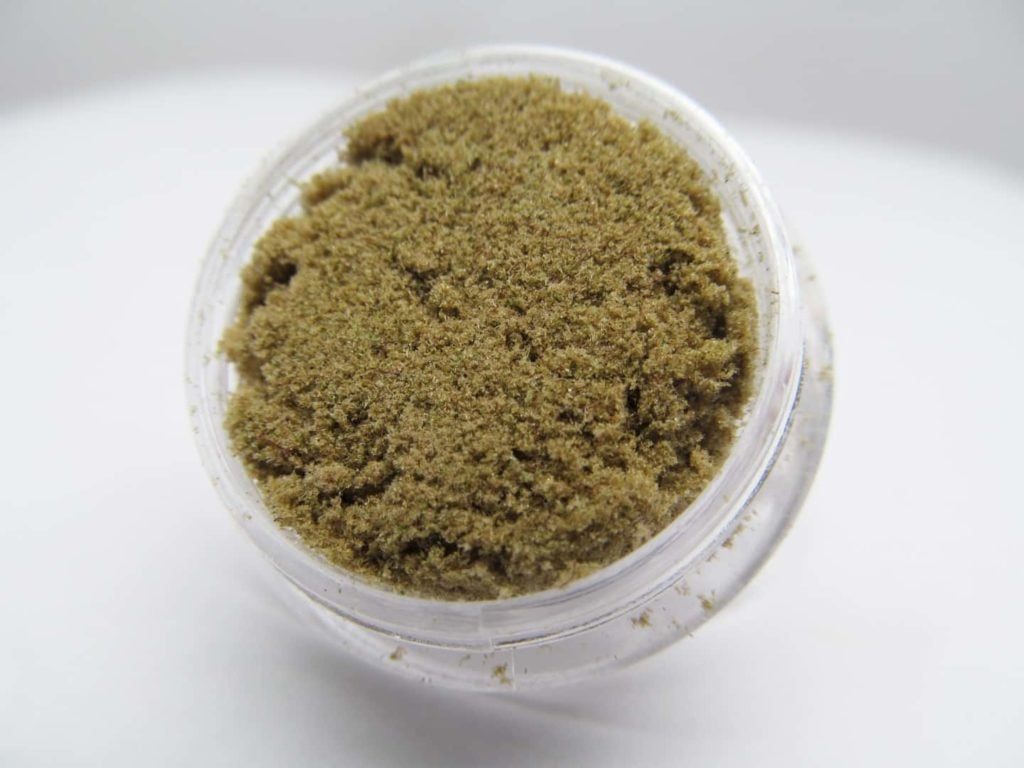
How to Make Kief
If you own a grinder with a screen and a small reservoir at the bottom, known as a kief catcher, you are probably familiar with this type of concentrate.
Hash
What is Hash?
Hash is usually considered hard-pressed kief or compressed resin made from the bud’s trichome. There is finger hash, bubble hash, and hash from the grinder. Because hash is made strictly from trichomes, it breaks apart easily and is extremely sticky.
What does hash look like?
Hash has a dark brown appearance.

How to Make Hash
To make hash, THC-rich trichomes are separated from the cannabis plant and condensed with high temperature and pressure. It is highly potent.
In this Leafly video, you’ll learn the cannabis craftsmanship on how to make hash.
Rosin
What is Rosin?
Rosin is a sticky substance created when heat and compression meet a bud of cannabis flower. Unlike hash which is made with just trichomes, rosin is made with the entire cannabis bud.
What does rosin look like?
Rosin has a clear, yellow-golden color like shatter but stickier with more viscosity.
How to Make Rosin
It’s as easy as this:
1. Put a nug folded up inside a piece of parchment paper
2. Press it in between two hot plates of a hair straightener for 3-5 minutes or until rosin sticks to the parchment paper
3. After it cools down, uses a dab tool to scrape it off and smoke.
Live Resin
What is Live Resin?
Live resin is a sticky wax-like concentrate that has more intense terpene flavors and smells compared to other marijuana concentrates. The THC or CBD content can range from 80% to 90%, that high.
This is because live resins are created from entire plants that are cryogenically frozen right after harvest preserving all terpenes that are usually lost during the drying and extraction process. They tend to look more clear and have a cleaner taste.
In 2023, live resin is now being sold in cartridges making it easier for consumers to consume. Now they are even able to extract Delta-8 and other cannabinoids’ live resins.
What does live resin look like?
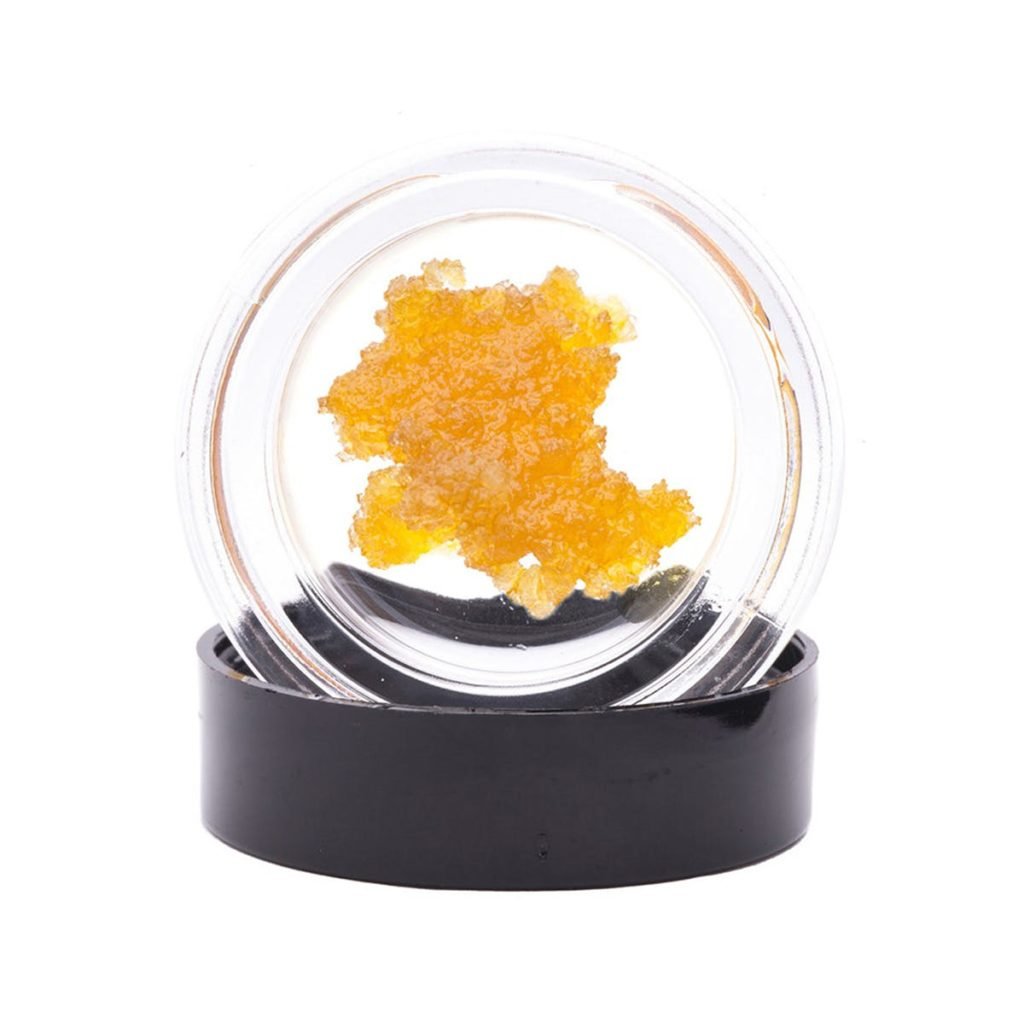
Weed Wax
What is Weed Wax?
Weed wax is a common word that categorizes certain types of cannabis concentrates that have a sticky, wax like textures. As the name suggests, wax concentrates resemble the texture of candle wax.
However, wax is a very broad term when it comes to the actual types of wax available to dab or smoke. Wax is used to describe shatter, crumble, honeycomb, budder and more.
What does weed wax look like?

Shatter Wax
What is Shatter Wax?
Shatter is a solid but sticky cannabis concentrate. It typically shatters into pieces when you go to pick up a dab.
Shatter is one of the most recognized concentrates, is easy to manipulate and is far less messy than other varieties of concentrates or extracts.
What does Shatter look like?
Shatter wax resembles a honey-colored glass shard or like a hard candy jolly rancher.
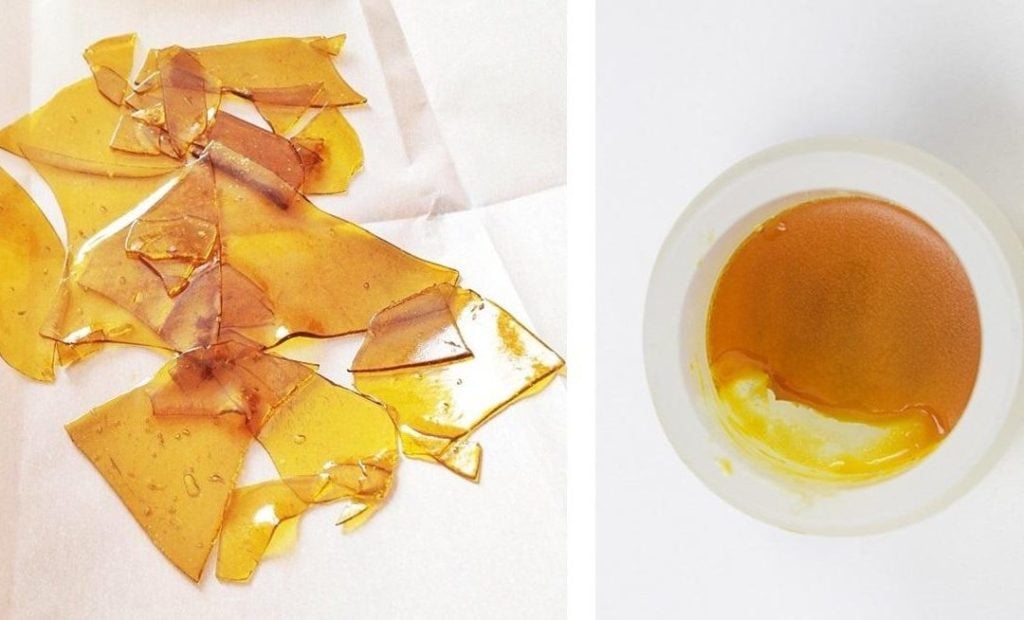
Honeycomb Wax
What is Honeycomb Wax?
Honeycomb wax is a lot like shatter except when extracted and laid out it creates holes within the concentrate like, you guessed it, a honeycomb.
What does honeycomb wax look like?
Honeycomb wax is a translucent concentrate that has a honey-amber shade.
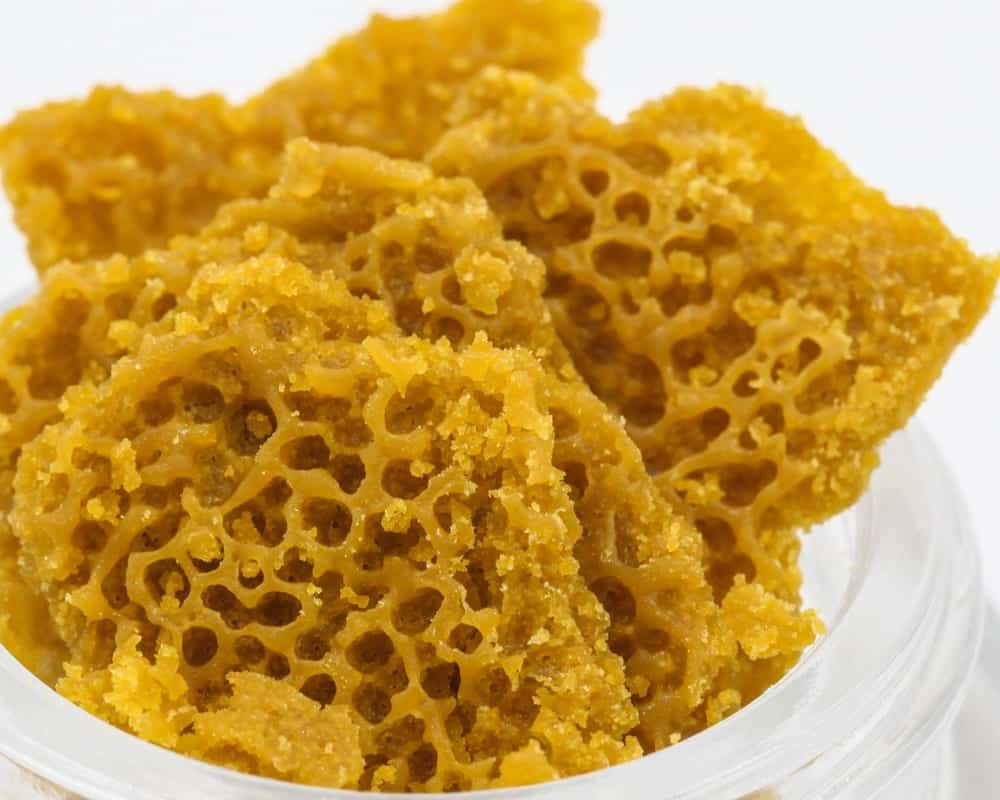
Crumble Wax
What is Crumble Wax?
Crumble is typically used to describe wax that is already broken up, or crumbled, hence the name. Since it always tends to crumble, this wax is considered harder to handle and less popular than other types of concentrates.
What does crumble wax look like?
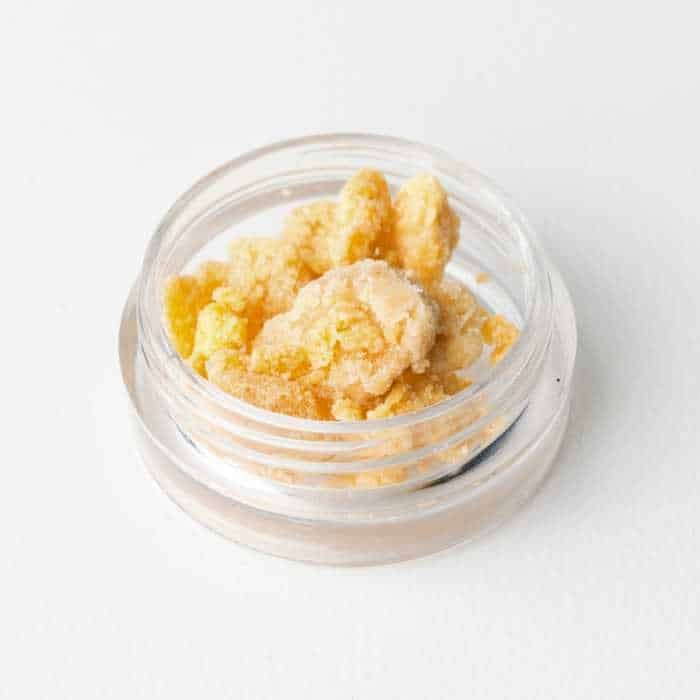
Budder or Badder Wax
What is Budder or Badder Wax?
Budder or badder wax has more viscous than most waxes, which makes it gooey and can almost be stirred. This is because budder is made at a higher temperature and is whipped like cake batter during the extraction process which is what gives its unique texture and consistency.
What does budder or badder wax look like?
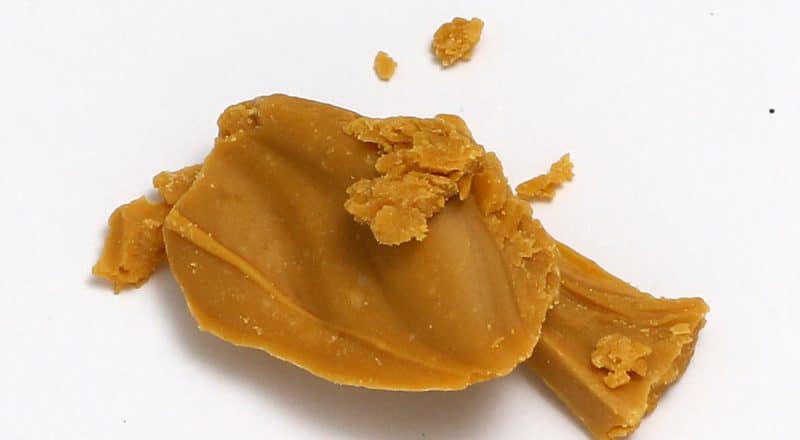
Pull and Snap
What is Pull and Snap?
Pull and snap looks very similar to shatter but has a taffy-like consistency. Instead of shattering into pieces, pull and snap is pulled from the parchment paper, reaches a breaking point, then snaps off. It, too, is honey-colored.
Cannabinoid-Focused Concentrates
The passing of the 2018 Farm Bill has allowed a range of new types of concentrates to hit the market. In this case, when I say types of concentrates, I mean the actual chemical makeup of the concentrates. Meaning you use to be able to only choose between THC or CBD concentrates. But since 2018, there have been new cannabinoid concentrates hitting the market:
Delta-8
Delta-10
THC-O
THC-P
HHC
You’ll find most of these cannabinoid concentrates in the same form as you do THC and CBD but mostly as an oil or wax. You most likely won’t find these products in a dispensary, but where legal, they will be in convenience stores and smoke shops. This market isn’t regulated in any way, so be cautious of the products you’re purchasing and always research the brands!
Tinctures
What is a THC, CBD or Marijuana Tincture?
Tinctures utilize decarboxylated cannabis, placed in a jar with high-proof alcohol like Everclear. The mixture is then stored for several weeks, strained and consumed.
It remains a liquid but will be green in color and is spiked with all the good stuff that has been leached out of the plant into the alcohol. However, there are many trusted CBD oil and THC tinctures available at most local dispensaries.

THC Oil or Hash Oil
What is THC or Hash Oil?
THC oil and hash oil names are commonly used to categorize all types of oil extracts that are produced from the cannabis plant.
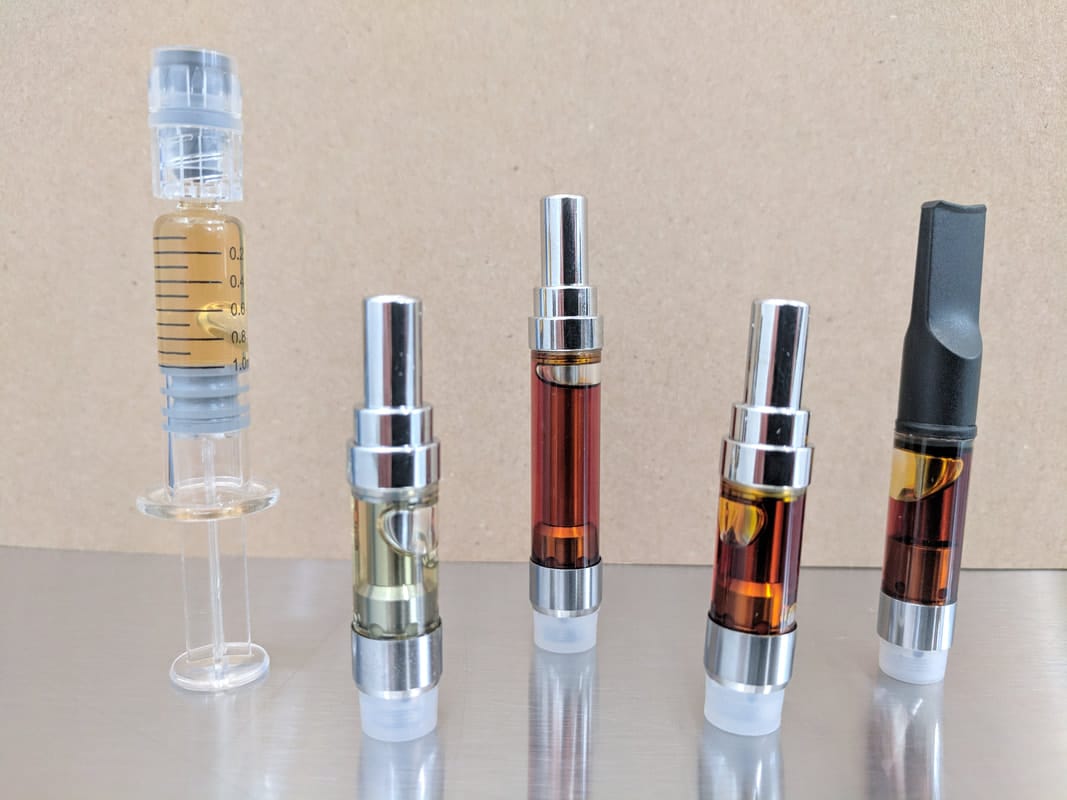
How to Make THC or Hash Oil
Hash oil or basic THC oil is made with alcohol and is produced by extracting the resin that is in the cannabis plant. The resin that is extracted dissolves in alcohol. After that the alcohol evaporates, leaving a thick, syrupy residue which is your THC oil. The higher the THC percentage in the flower that you use, the higher the THC in the resulting oil.
However, it’s difficult to make hash oil without the proper equipment or space, which can be costly. That’s why many first-timers start by making kief, bubble hash or solventless concentrates.

CBD Oil
What is CBD Oil?
CBD oils have THC and psychoactive cannabinoids removed leaving only pure CBD behind. The most popular CBD oil on the market is Charlotte’s Web, a Sativa marijuana strain.
How is CBD Oil Made?
It’s extremely hard to make pure CBD that you can smoke without the expensive and necessary equipment.
Commercial operations extract CBD by using whole cannabis and hemp plants, except for the roots.
The CBD extraction process is very similar to the THC extraction process – the only difference is that the resulting oil will have no THC or psychoactive qualities. Because CBD is totally legal, making CBD oil from hemp is legal and results in no legal ramifications for possession or manufacturing.
How to Make CBD Oil at Home
There are two main ways to make CBD oil at home.
1. Use an oil-based solvent such as olive oil, coconut oil or hemp seed oil as the solvent to pull out and extract the CBD from the plant.
2. Buy pure CBD isolate crystals or powder and make a tincture by mixing it with a coconut or MCT oil.
It’s important to note, if you’re looking to make a pure CBD oil at home that only has CBD active ingredients, then you will need to purchase flower that has little to NO THC content in it, such as Charlotte’s Web or hemp.
Butane/BHO Oil/Honey Oil
What is BHO or Butane Honey Oil?
BHO stands for Butane Hash Oil or sometimes referred to as Butane Honey Oil. BHO is a resin that is extracted from the cannabis plant with butane being used as the solvent.
How to Make Butane Honey Oil (BHO)
BHO was originally made through a process called “blasting” or “open blasting” which is really not done commercially anymore but is often the cause behind at-home manufacturing explosions.
This technique is outdated, to say the least. During the butane extraction process, gas passes through a tube open at one end, often made of glass, stainless steel or PVC, which is filled with cannabis plant matter.
A low temperature, liquid butane passes over the plant matter, is collected at the other end and crystallizes the resins in the cannabis. The butane is then left to evaporate, by heat or vacuum oven, and what is left over is known as BHO.
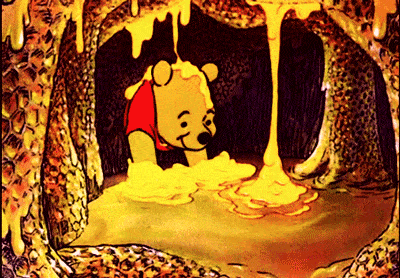
It is a hazardous process and wastes a lot of cannabis, making it not the most cost-effective way to create BHO either. When blasting, there is no way to contain the extremely flammable butane – so when you are open blasting any type of ignition can create an explosion.
We will not be going to go into detail on how to perform open blasting, it is dangerous and we won’t be responsible for passing that knowledge along.
However, blasting is not the only way to make BHO. Due to the extremely hazardous conditions caused by blasting, a new concept has been adopted – Closed Loop Extraction. And it isn’t just better because it isn’t an explosive technique – there are other reasons it is superior to blasting.
In closed-loop extractions, solvents are put into a pressurized tank which is connected to an extraction tube which is where plant materials are stored. Leftover, or residual, solvents then collect in a recovery tank. Solvents in the recovery tank can be stored and reused – so it is a very sustainable process as well.
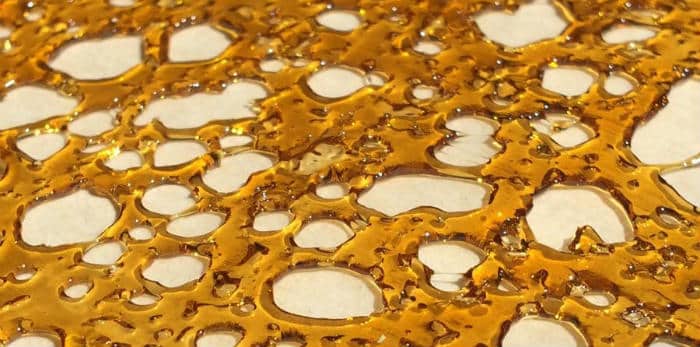
People are also debating whether or not consuming butane is safe. When you use a lighter to light a bong, pipe, joint or cigarette – you are inhaling a trace amount of butane…but there has not been enough research done to say if butane consumption is creating long-lasting health hazards or not. Buyer beware.
CO2 Oil
What is CO2 Oil?
Supercritical fluid extraction of SFE is the preferred process for CO2 Oil extractions. What is Supercritical Fluid Extraction? During this process, components are separated using Carbon Dioxide or CO2.
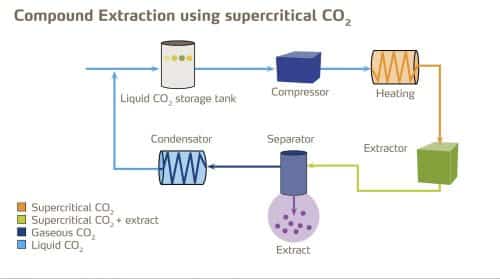
The word supercritical plays in because in chemistry, “supercritical” means “any substance at a temperature and pressure above its critical point, where distinct liquid and gas phases do not exist.” In this supercritical state, the product is able to be broken down and separated.
Only then is it able to pass over cannabis plant matter and dissolve the membrane of trichomes and separate substances. CO2 extraction is capable of extracting THCA, CBD, CBG and THCV to name a few. CO2 extractions can also separate terpenes and other vital compounds in cannabis.
The enriched CO2 solvent is then passed into another tank, a pressurized separation vessel, and changing pressures and temperatures are used to complete the process of separation. The remaining CO2 is restabilized into gas and as we said above, often reused.
Even the FDA recognized Supercritical CO2 extractions as safe for industrial extractions – not in cannabis of course, but for other botanical products and such.
Rick Simpson Oil (RSO)
What is Rick Simpson Oil?
When properly made, Rick Simpson oil is a thicker liquid than a tincture, but viscous enough to not be a solid either. It is more popularly utilized in a pre-filled vape pen and can also be placed inside capsules for oral ingestion.
RSO is easy peasy to make at home on your own and is not too much different than making cannabutter or other cannabis oils.
Simpson’s recommendation is to use Indica strains exclusively, but a patient can use whichever strain they prefer. Visit Leafly for the full recipe and process.
Distillate
What is a Marijuana Distillate?
Distillate is a refined, or distilled, version of a cannabis extract. After extraction, the distillate is run through a purification process several times. The result is a liquid, clarified distillate, much like honey in color and consistency.
Distillation is used in the alcohol industry to remove methanol and ethanol used in alcohol production. It is the process used to separate compounds by utilizing their unique boiling points.
During this process, cannabis oils are purified by heating cannabinoids to their boiling point. The resulting cannabinoid-rich vapor is condensed and collected – while residual solvents, chlorophyll and other unwanted plant matter are left behind.
This does remove most if not all of the terpenes in cannabis oil, however, as the temperatures are too high for the terpenes to survive the process.
With that said, manufacturers are now playing with the re-introduction or terpenes to the oil after the process. The distillation method can be repeated multiple times in order to produce the purest product possible.
Isolates & Crystallines
What are cannabis isolates and crystallines?
Isolates and crystallines are the purest forms of concentrate on the market. There are lab-tested THC or CBD isolates that have 99.9% active cannabinoid contents in them.
In order for it to be a pure isolate, the THC or CBD must be extracted and isolated from all other cannabinoids. This means, during the extraction process all terpenes, flavonoids, fats, and other marijuana content is completely removed.
After the entire extraction takes place, all that remains are pure isolate crystals which appear as crystalline powder. Since all other solvents and cannabinoids are removed, isolates tend to have no color, flavor, or aroma.
What do isolates look like?

Cannabis Concentrates & Extracts Prices
What is the price of a cannabis extract? Well, it depends. We are going to be talking averages here because nailing down a universal price isn’t realistic.
So you might have seen it go for more, you might have paid less at some point – but for the sake of putting an average number on it, these are the prices we discovered after researching concentrates at the top dispensaries in Denver.
Concentrates priced at $15-$35 a gram
Kief, Hash & Wax Prices
At this price point, you can get a gram of kief, hash or wax. Research from hundreds of dispensaries shows that $20 to $25 a gram seems pretty average for kief prices. Within the last several years as more states legalize, we’ve noticed you can even get grams as low as $12.
However, you COULD just purchase a grinder with a kief catcher and collect your own. Bubble hash can be around $30 a gram, but the hash that is a chemically extracted product can cost up to $100 a gram.
As for wax prices, you can expect to pay around $30 a gram, depending on the wax you are choosing.
Concentrates priced at $40-$55 a gram
Rosin, Shatter & Oil Prices
For about $40 to $55, you can get yourself a gram of rosin, shatter, pull and snap, 250-500 mgs of cannabis oil, or 32 ml of tincture. Depending on the quality and brand of rosin, you could pay an average of $45 a gram.
The average cost for quality shatter is about $40 a gram. Pull and snap can range between $30-$50 or an average of $40 per gram. A vape pen cartridge filled with cannabis oil can be anywhere from $30-$60. If you want hash oil you’ll be looking at around $50 per gram.
Pure THC Oil
Pure THC oil can be bought as a tincture, but you aren’t going to be buying a gram of tincture because it is a liquid and will be measured in milliliters. Thirty-two ml tincture of pure THC oil will be priced at $50 to $60.
Concentrates priced at $100-$200 a gram
Distillate, Isolates & Crystalline prices
Yes, this sounds a little crazy, but both distillate and crystalline will cost a pretty penny. Users need to use much less at a time than other concentrates to feel the effects, both of these products should last you for some time.
Because of its high quality and high potency, distillate can go for up to $120 a gram! Wowzers!
However, keep an eye out because prices for distillate have been dropping and it can be found for $50 a gram, sometimes even as low as $20 – though you might want to question the purity and quality of such a cheap product.
A gram of crystalline will be anywhere from $100-$200 for one gram because again, the high quality and high THC potency are going to cost you.
Future of Cannabis Concentrates
The future is bright for concentrates and consumers. There are three major trends to look out for, water-soluble concentrates, the expansion of live resin, and advanced paraphernalia devices to consume concentrates. Water-soluble concentrates will allow for the concentrates to be mixed in beverages to create a potent, delicious buzz. Live resin is becoming more popular with its unique flavor and high terpene content. The taste is superb and you can now find them in many 0.3, 0.5, and gram cartridges. And dab devices are becoming more portable and more discreet, allowing concentrates to be consumed easily.
As legalization continues to spread, we may see more government regulation of concentrates including requirements for testing, labeling, and extraction methods.
Article Recap:
- Cannabis concentrates are created and extracted from the cannabis plant, meaning they are much more potent than the flower alone.
- There are two main types of concentrates solvent-based and solventless concentrates.
- Solvent-based concentrates use a liquid, gas, or type of solvent to extract cannabinoids from marijuana plants. Solvent-based concentrates include: shatter, crumble, honeycomb, wax products, and vary of extract marijuana oils.
- Solventless or solvent-free concentrates are byproducts of cannabis plants and buds. Solventless concentrates include kief, rosin, hash, distillates, isolates, and crystallines.
- Stoner Tuesday Sale 2024!! Buy One Get One + 30% off bookings & 25% off gift cards! Cyber Monday all week fam. - November 27, 2024
- Colorado Cannabis Tours Receives Marijuana Hospitality License From the City of Denver - April 19, 2023
- Cannabis Concentrates Guide: THC Oils, Hash, Wax, Shatter & Dabs - April 11, 2023


How much is topical thc oil. My friend rubs this on her joints. Says it helps. How much?